 (4)
(4)
Retro Futurism
Futurism on its own represents all of people’s imagination of the future as taken from a past perception. Retro-futurism, however, recollects and reflects on this imagination. The image above, for example, is a depiction of Chicago in the retro futuristic aesthetic. The art style is similar to the political cartoons of the 19th and 20th centuries, but the train, airship and architecture look somehow both futuristic and old-fashioned in the way they are constructed. This poster and all other depictions of cities in a retro futuristic style found in this article are by artists Jim Michaelson, Maureen Johnston and R. Ziscis, and they all follow this same form, being a good representation of retro futurism as a genre and aesthetic. First explicitly mentioned by publisher Lloyd Dunn in 19831, retro futurism can be broken down into two subcategories: the retro futuristic genre, and retro futuristic artifacts2. On one hand, the retro futuristic genre includes modern art, literature, film and more which are meant to mimic retro styles and/or visions of the future coming from a previous era or time period2. Furthermore, instead of being art that depicts the future, this genre also applies when futuristic technologies are applied to a time in history, like in the case of Steampunk. On the other hand, retro futuristic artifacts include any film, books, magazines, advertisements, products, etc. that envision a depiction of future technology and society that comes from the time it was produced2.
 (4)
(4)
Subgenres of Retro Futurism
Retrofuturism has several subgenres, many of which have the suffix “punk.” For example, Steampunk, Dieselpunk, Decopunk, Atompunk, and Cyberpunk are all subgenres of the Retro Futuristic genre2. In all of these subgenres, “punk” has the same meaning: reference to reinvention of the future2. Steampunk is the oldest example of retrofuturism, actually predating the larger genre itself as both a literary genre and an aesthetic design style. Victorian settings are often incorporated into a steampunk style, along with gears, airships and muted natural colors2. “Mechanical Insect” by Francesc Grimalt (below) is an interesting example of this, showing the internal mechanical workings of an almost dystopian style creation.
 (5)
(5)
Influence
Overall, retrofuturism has had a significant impact on some of the modern appeal of old styles of art, clothing and design, in addition to leading to creative innovations and products that come up frequently3. Retro futurism is not just about science and technology, either. The aesthetic also brings about nostalgia in a couple different ways. There’s the artifact example, where traditional nostalgia occurs after one sees the art style of a past generation. In addition to this, though, is a fascinating phenomenon that occurs with new material and art which falls under the genre of retrofuturism, best described as “faux” nostalgia3. Interestingly, although the future never happened (obviously), humans feel nostalgic when viewing art that takes them into a future-based connotation. Take “Ships Cat” by Keith Spangle, which can be seen below, as an example of this. Retrofuturism can be seen as a future that never happened, one where there are cats on spaceships3.
Finally, retrofuturism gives us an interesting perspective on human civilization, especially when one compares examples of retrofuturism from different periods of time. As we observe the change in societal expectations from the future through different eras, we can narrow down our expectations for the future into more realistic ones. Steampunk and cyberpunk, as it turns out, are not just interesting sectors of art and design solely to be turned into a game, but they are also a fascinating method of chronicling human perception of the future during different eras.

“Diesel Forces” by Stefan Prohaczka
 (4)
(4)
 (4)
(4)
References
1The Origin and Application of Retro-futurism by Liu Jihong, Journal of Landscape Research, 2019. https://www.proquest.com/openview/07f84fd8dbf8241cae4876b45ce8baa3/1?pq-origsite=gscholar&cbl=1596366
2What is Retrofuturism? The Retrofuturist, 2024, https://theretrofuturist.com/what-is-retrofuturism/
3Retro-futurism and why it matters: a foray into alternative futures seen from the past, by Rupendra Brahambhatt, 9/28/21, https://www.zmescience.com/feature-post/culture/culture-society/retro-futurism-and-why-it-matters-a-foray-into-alternative-futures-seen-from-the-past/
4Posters in a Retro futuristic style by artists Jim Michaelson, Maureen Johnston and R. Ziscis.
5 “Mechanical Insect” by Francesc Grimalt.


4 Comments. Leave new
Hi, I found your post on Retrofuturism very intriguing. You provided a comprehensive and insightful exploration of retrofuturism, delving into its definition, subgenres, and influence on various aspects of art and culture. The breakdown of retrofuturism into retro-futuristic genres and artifacts, along with the discussion of subgenres like Steampunk and Cyberpunk, showcases a nuanced understanding of this evolving aesthetic movement. What are your thoughts about the contribution of retrofuturism to the reinvention of old styles and the shaping of art and design in the future?
Thank you for the kind words Venkata! In response to your question, id like to think that retrofuturism will continue to shape the art and design of the foreseeable future by reinventing old styles. In my opinion, humans will always feel some sort of charm and/or nostalgia from this genre and therefore will continue to create works of art that follow it.
Your perspective on how nostalgia is evoked and how different subgenres of retrofuturism reflects the futuristic ideas of an era was fun to read, and explains why the contrasting elements of the aesthetic is so captivating to its audience. I am curious where and when the example artworks came from and how the elements presented in each compare to one another.
Thanks for the feedback Helen! I’ve added some context for the example artworks, as well as added a comparison between the different artworks. I think they are a fascinating representation of the genre and do deserve more elaboration.